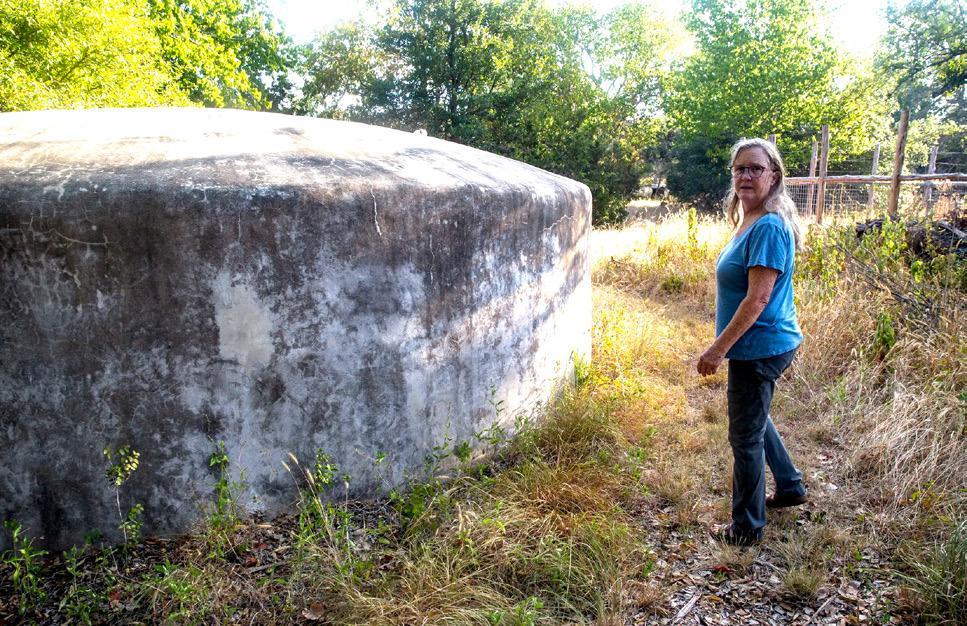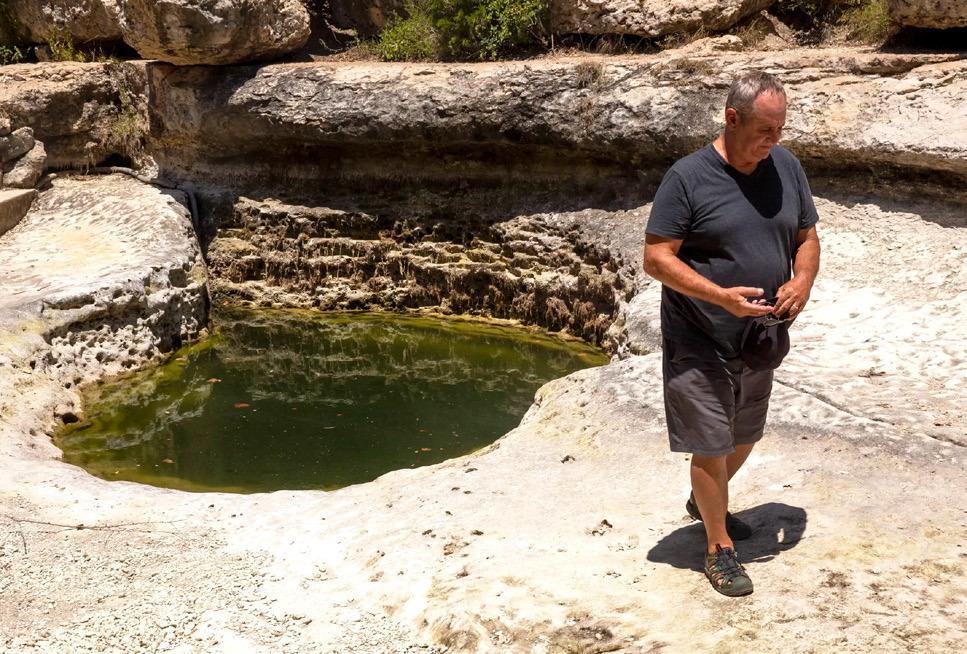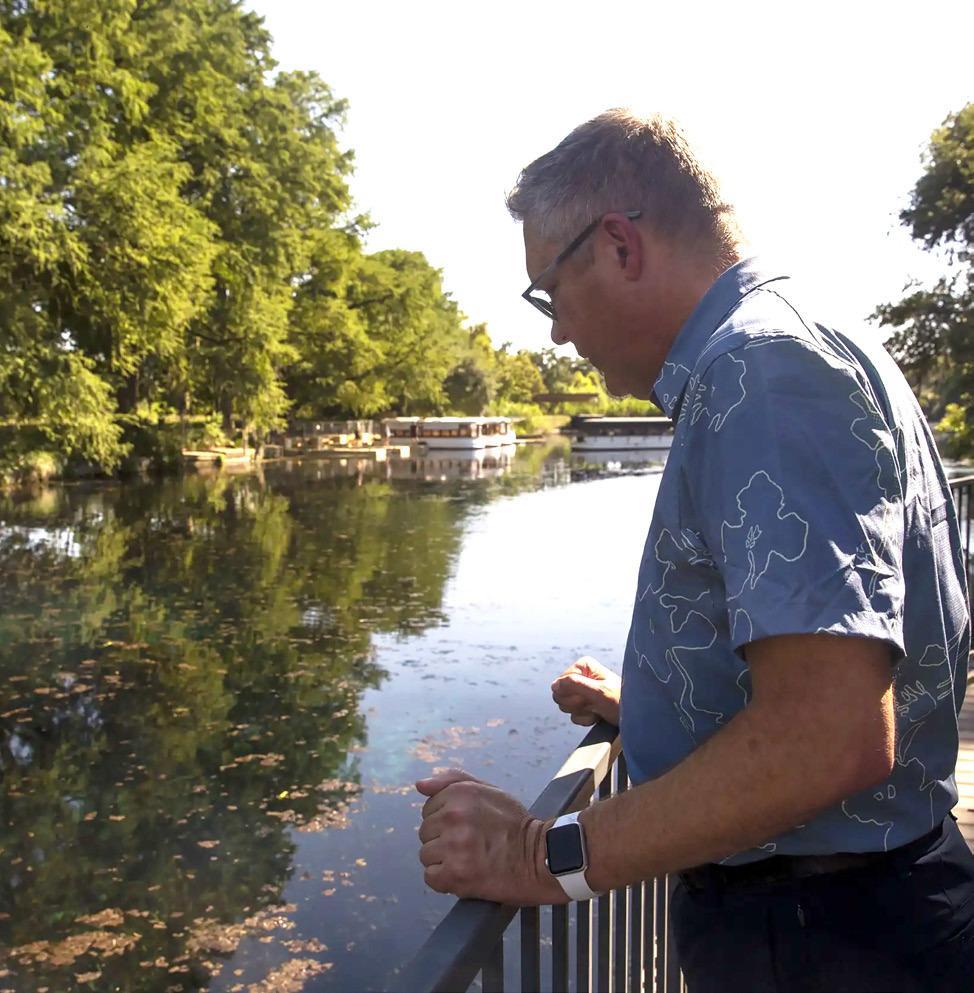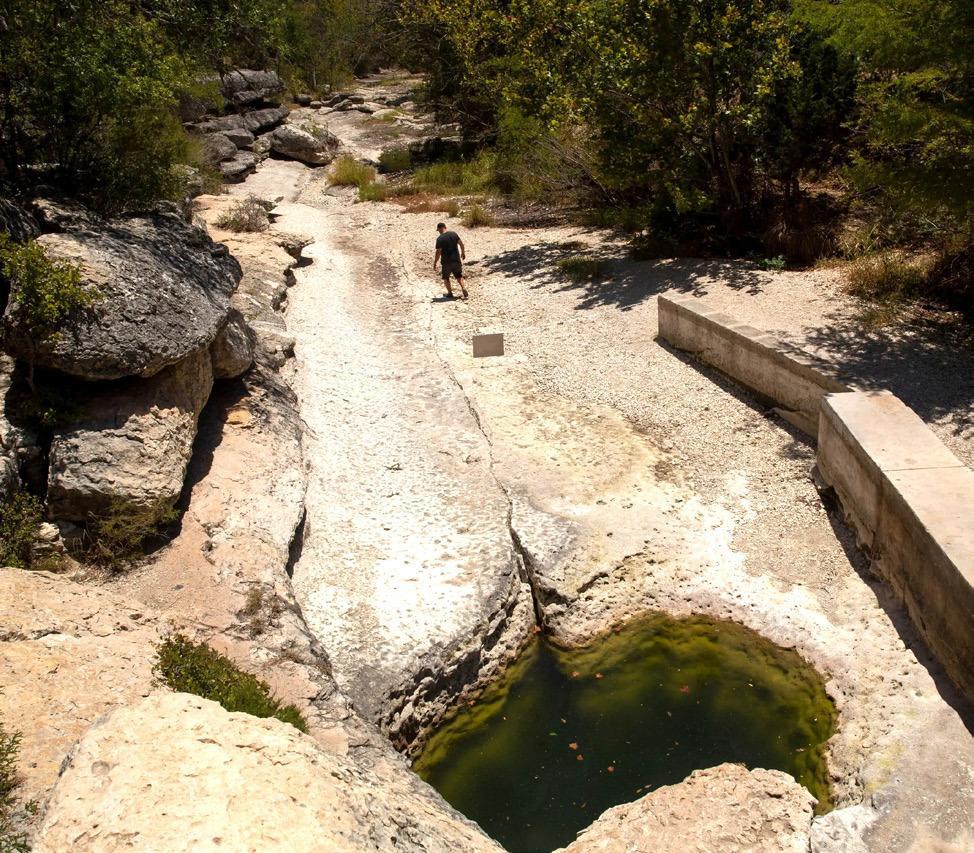



Top left, Cathy Ramsey, Western Hays County project coordinator for the Save Our Springs Alliance, stands by her 20,000-gallon rainwater cistern in Dripping Springs. Top right, Robert Mace, executive director of the Meadows Center for Water and the Environment at Texas State University, points out features in San Marcos Springs. Above/right, David Baker, founder/director of the Wimberley Watershed Association, has seen Jacob’s Well stop flowing six times; he’s never seen the water as low as it is now.
Photos by Dylan Baddour/Inside Climate News
Heat, drought, population growth stress aquifers that supply millions
Almost every other day, Charlie Flatten gets a call about another local water well gone dry.
Last week, he tried to help one woman find a water truck to fill her home cistern. But all the hauling companies had suspended service amid a deepening shortage in Central Texas.
“She’s got to go find somewhere else to live,” said Flatten, general manager of the Hays Trinity Groundwater Conservation District in Dripping Springs. “This is extremely serious.”
Here in the booming Hill Country southwest of Austin, Flatten said, the Trinity Aquifer is at its lowest level on record. Across the region, iconic natural springs are dwindling or drying up, victims of extreme heat, persistent drought and ever- growing demand for water.
This May, Flatten’s district issued a moratorium on groundwater pumping for the first time in its history. Meanwhile, he said, a private company called Aqua Texas, which provides water utilities to more than 50 Texas counties, continues pumping millions more gallons than it is authorized to take. And there isn’t much he can do about it.
“Their business model does not benefit from conservation,” Flatten said of Aqua Texas, a subsidiary of Essential Utilities, an investor- owned utility with a $10.4 billion market capitalization. “Their business model benefits from selling water, and their shareholders expect them to turn a profit every quarter.”
Flatten sent Aqua Texas a $450,000 fine for pumping almost twice as much as its permit allowed last year, but the company hasn’t paid. Settlement negotiations continue, along with excessive pumping, Flatten said.
“We have contested the over pumping fee with the groundwater district and are currently working closely with them to get that resolved,” said Aqua Texas spokesperson Jennifer Olo- han.
“The fee was for over pumping the drought curtailment numbers and not for over pumping the totality of our permit.”
After months of requests from local leaders, Aqua on Friday banned all outdoor water use by its customers.
This situation highlights a critical weakness of aquifer management in Texas, according to Vanessa Puig-Williams, Texas water program director for the Environmental Defense Fund.
A 2022 report by EDF examined the long-term goals of groundwater conservation districts. It revealed that some regions were managing groundwater in ways that could lead to its eventual exhaustion due to challenges like lack of funding to gather groundwater data. The study found that goals also often fail to account for the local impacts stemming from increased groundwater pumping and drought.
“We are asking our local groundwater conservation districts to do the impossible,” she said. “I think we’ve set ourselves up for a disaster, and I think we’re starting to see it in Central Texas.”
Dry springs of Central Texas
The cavernous, limestone aquifers of Central Texas produce a notable collection of springs that have nurtured human habitation here for millenia.
Ancient footpaths once followed this line of water features along where the Hill Country meets the coastal plains. Later, the Spanish road through Texas took the route. Today it’s the Interstate 35 corridor–one of the fastest- growing regions in the country — and the powerful springs mark the spots that would become Austin, San Marcos, New Braunfels and San Antonio.
Central Texas’ largest springs, which come from the Edwards Aquifer, are approaching their lowest flow levels on record, according to Robert Mace, executive director of the Meadows Center for Water and the Environment at Texas State University in San Marcos.
Standing beside a springfed pool, he pointed to a dry, rocky hole at the water’s edge.
“It’s usually just gushing out of here,” Mace said as afternoon temperatures approached 105 degrees. “I’ve never seen it like this. This is the worst it’s been.”
San Marcos Springs, historically the second-largest in Texas, is flowing at just 50% of its historical average for this time of year.
“As we continue to get warmer and warmer, we’re gonna see less and less recharge to the Edwards Aquifer, which means it’s going to threaten our springs,” he said. The largest spring complex in Texas, Comal Springs in nearby New Braunfels, is flowing at 30% of its historical average for August. Its primary spring has gone completely dry.
Las Moras Springs in Brackettville, west of San Antonio, has also stopped flowing.
Barton Springs in Austin is flowing at about 14 cubic feet per second. Its average flow over the last 45 years is 67 cubic feet per second, according to Tim Loftus, manager of the Barton Springs Edwards Aquifer Conservation District, which supplies major customers including the Goforth Special Utility District and the city of Kyle.
“We’re starting to enter rare territory,” Loftus said.
The lowest flow recorded at Barton Springs was 10 cubic feet per second during the drought of the 1950s–a decade-long dry spell that still stands as the worst in Texas history and the lowest point for the Edwards Aquifer springs.
There is one big difference between the 1950s and now. Back then, there were fewer than 8 million people in Texas. Today, there are 30 million. Texas has gained more residents than any other U.S. state since the turn of this century, and none of them brought their own water.
Current heat and rainfall conditions rival the intensity of the 1950s drought, said Roland Ruiz, manager of the Edwards Aquifer Authority in San Antonio. Back then, however, these conditions lingered for almost 10 years.
“This drought is not nearly as long in duration, at least not yet,” he said. “In terms of temperature, it’s more intense.”
Levels in the Edwards Aquifer, which supplies drinking water for nearly 2 million people, are about 50 feet below average for this time of year, according to Paul Bertetti, senior director for aquifer science research and modeling with the Edwards Aquifer Authority.
Last week, he told a board meeting of the aquifer authority that only a “deluge event” would begin to return normal conditions. But dry heat still dominated the forecast for weeks to come.
“August doesn’t look good,” Bertetti said. “Above-normal rainfall is not expected until winter months.”
According to Todd H. Votteler, co-founder of the Texas Water Journal, Central Texas is in the “bullseye” of the current drought. Votteler said this underscores the challenge faced by water managers: the unpredictable duration of droughts. Consequently, he said, water suppliers should manage with a prolonged- drought mindset.
“The kind of drought that we are in right now, it does give you a sense of how well prepared we are and whether we have the supplies for future growth that we need,” he said. “Invested in this carpet grass.”
When it comes to water conservation, there’s one high-volume use that planners agree must be first to go: the lawn.
Summertime outdoor water use accounts for 50% to 80% of residential consumption, according to the Texas Water Development Board. Most of it goes onto turf grass.
“We’ve asked our customers to basically let their lawns die, and that is not acceptable to a lot of people,” said Eric Ingram, operations manager of the water supply company in the Hill Country town of Comfort. “They tell us, ‘We’ve got thousands of dollars invested in this carpet grass.’ Well, we live in a desert now.”
The city of Manor banned sprinkler use for the first time in its history. Residents may only water by hand. City Manager Scott Moore said the number of residential water accounts in Manor grew by 144% since 2013. Since 2016, the city has registered 2,376 residential and 135 commercial irrigation systems, he said.
The city of Georgetown, the fastest-growing U.S. city, also banned sprinkler use in some of its territory for the first time since 2011, citing the inability of a neighboring city, Leander, to supply water.
“Not being allowed to water our lawns is far from ideal. However, having safe drinking water for our customers must take priority over pristine, green lawns,” said Georgetown Mayor Josh Schroeder in a public announcement.
In several cases, widespread irrigation of grass caused water system problems as supply grew short. For example, some residents of Bee Cave woke up to low or no water pressure in late June.
“The storage tanks were drained overnight by Over-irrigation of lawns,” Bee Cave mayor Kara King wrote on Facebook.
The same thing happened in Dripping Springs, where some residents received a boil-water notification on July 20. Rick Broun, general manager for the local water supply company, told the Dripping Springs Century News that the loss in system pressure resulted from “an enormous amount of irrigation use last night.”
Water conservation strategies Residents and developers must reform their water use habits as the population of Central Texas continues to grow, said Cathy Ramsey, a Dripping Springs resident and Western Hays County project coordinator for the Save Our Springs Alliance.
“Not many people are aware that the groundwater is extremely stressed right now,” she said. “The land looks dismal, wells are going dry and new developments keep on coming in, so it’s a little alarming.”
She has no well on her 10acre semi-rural lot. Instead, pipes channel rainwater that falls on her house into a 20,000 gallon cistern that sits half-buried near her house. She uses nontoxic detergents so her sinks and showers can drain into gardens outside.
Ramsey doesn’t grow a lawn. She lets the native grasses grow tall. Some of their roots can reach more than 15 feet below ground, she said, giving them excellent drought tolerance.
“We’re destroying our springs to have lawns,” she said. “How sad.”
Native grasses alone won’t save Texas from water scarcity. Sustainable growth will require a combination of tactics on multiple fronts, said Perry Fowler, executive director of the Texas Water Infrastructure Network.
He said priorities should include repairs to widespread leakage in aging water systems, adoption of reuse technologies, construction of new reservoirs and, ultimately, development of desalination plants.
“Based on the population growth projections that we’re seeing right now, we don’t have adequate water,” Fowler said. “The weather just exacerbates the problem.”
Water infrastructure in Texas has typically relied on federal money from the Clean Water State Revolving Fund, he said, but increasing earmarks in national legislation are decreasing the amount available to Texas.
In November, Texas will vote on a proposed amendment to the state constitution– known as Proposition 6–that will establish a state water fund.
“I think a lightbulb went off this last [legislative] session showing that people are viewing water as more of a priority,” Fowler said. “We’re going to be struggling just to maintain the level of funding that we rely on here.”
Marisa Bruno, water program manager for the Hill Country Alliance, said cities should adopt a system known as “One Water,” in which a single authority runs an integrated system for water supply, wastewater and stormwater drainage, full of built-in opportunities for reuse.
“We’re going to just have to make some changes,” she said. “I don’t think business as usual is going to cut it.”
The case of Aqua Texas
On a sweltering summer afternoon, 53-year-old Horacio Aguirre crossed his arms as he stared into a green, mucky puddle. He’d driven three hours from Houston to show his granddaughter Jacob’s Well, an iconic Hill Country swimming hole, only to find it dried up.
“I can’t believe it,” said Aguirre, an industrial mechanic. “This is sad.”
Standing nearby in the shade, David Baker nodded in agreement. The founder and director of the Wimberley Watershed Association, he’s dedicated the last 30 years to protecting Jacob’s Well. In that time, he’s seen it stop flowing six times. But he’s never seen the water as low as it is now. “Jacob’s Well is the canary in the coal mine for the aquifer. The canary is gasping for breath right now,” Baker said.
It’s not just the drought, he said. Massive volumes of groundwater pumping are equally to blame–specifically, Baker said, Aqua Texas, the investor-owned water utility that’s been flaunting its permits.
When Baker started the Watershed Association in 1996, he said, there were 50 houses in the Woodcreek neighborhood. Now there are 1,500, with more than 2,000 lots yet to be developed, all serviced by Aqua Texas.
Hays County, which includes Jacob’s Well, ranked as the fourth fastest-growing U.S. county last year, tied with its neighbor, Comal County. Every gallon now sprayed onto lawns or flushed down toilets in these neighborhoods used to flow out of Jacob’s Well, Baker said.
“Across the region, we’re losing 2 to 3 feet of groundwater levels every year,” he said. “Let’s be conscious that this is a finite resource.”
Aqua Texas, which supplies water to 280,000 customers in Texas, said in a statement it is taking steps to reduce the impacts of its pumping. The company said it has purchased additional land outside the Jacob’s Well area in order to explore the possibility of using a different aquifer, and that it is building a new treatment plant to reuse wastewater for lawn irrigation. Aqua Texas also plans to spend $3 million this year replacing underground pipes.
“We live here and understand the importance of finding a solution to the water issues. We can’t fix it overnight,” Aqua Texas President Craig Blanchette said in a statement.
But Flatten, the manager of the Hays Trinity Groundwater Conservation District, said time is running out and there isn’t much he can do to enforce less pumping. Each of the 98 groundwater conservation districts in Texas has different rules and powers. Most of them don’t have authority to deny permits to pump groundwater, which is considered a landowner’s private property. (The districts may enact a temporary moratorium on new permits, like Hays Trinity has done.) “I can’t go out and turn their taps off,” Flatten said. “We’re running out of time.”
The population of Dripping Springs has tripled in 10 years. Flatten estimated that if 100 residents were asked the location of the city’s namesake springs, none of them would know. So they wouldn’t know, either, that those springs are also totally dry.
“The springs are a window to the aquifer,” he said. “If you see a dried-up spring, that means every nearby water well is at risk.”
Alejandra Martinez of The Texas Tribune contributed to this report.
Disclosure: Edwards Aquifer Authority, Environmental Defense Fund and Hill Country Alliance have been financial supporters of The Texas Tribune, a nonprofit, nonpartisan news organization that is funded in part by donations from members, foundations and corporate sponsors. Financial supporters play no role in the Tribune's journalism. Find a complete list of them here.
This story is published in partnership with Inside Climate News, a nonprofit, independent news organization that covers climate, energy and the environment. Sign up for the ICN newsletter here.
Correction, Aug. 16, 2023 at 3:21 p.m.: A previous version of this story included the wrong title for Eric Ingram. He is the operations manager for Comfort's water supply company, not the general manager.











